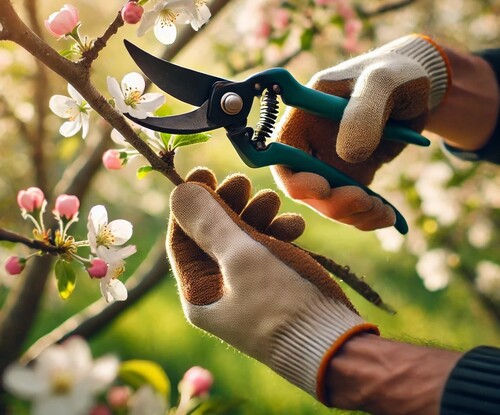Essential Spring Tree Care: 4 Tips for Vibrant and Healthy Trees
Introduction
As the winter chill fades and new growth begins, it’s crucial to ensure your trees are prepared for the changing seasons. This guide will walk you through the top spring tree care practices, helping you maintain a lush, healthy landscape throughout the year.
Why Spring Tree Care Matters
Before diving into specific tips, let’s consider why spring tree care is so important:
- Promotes healthy growth for the upcoming season
- Prevents potential issues caused by winter damage
- Enhances the overall aesthetics of your landscape
- Increases property value through well-maintained trees
Now, let’s explore the four essential spring tree care tips that will set your landscape up for success.
1. Pruning: The Foundation of Healthy Trees

A Gardener Pruning a Flowering Tree with Precision
Proper pruning is crucial for maintaining tree health, safety, and appearance.
Benefits of Spring Pruning:
- Removes winter-damaged or unsafe branches
- Promotes healthy growth patterns
- Improves air circulation and sunlight penetration
- Allows for early detection of potential tree health issues
Pruning Best Practices:
- Use clean, sharp tools to make clean cuts
- Remove dead, diseased, or crossing branches first
- Avoid removing more than 25 percent of live branches in a single season
- Make cuts just outside the branch collar for proper healing
Expert Tip: ” Proper pruning cuts are crucial for tree health. Always cut at a 45-degree angle just outside the branch collar to promote quick healing,” advises certified arborist John Smith.
2. Top Up And/Or Replace Mulch
Mulching is a simple yet effective way to improve soil health and protect tree roots.
Mulching Benefits:
- Conserves soil moisture
- Suppresses weed growth
- Regulates soil temperature
- Improves soil structure over time
Proper Mulching Technique:
- Apply a 3-to-5-inch layer of mulch
- Start a few inches away from the trunk to prevent moisture buildup
- Extend the mulch 1-2 feet out from the tree in all directions
- Use organic mulch like wood chips or bark for added nutrients
Pro Tip: Avoid “volcano mulching”—piling mulch against the tree trunk—as this can lead to decay and pest issues.
3. Moisture Management and Health Check

An Arborist Conducting a Tree Health Assessment
Regular monitoring of soil moisture and overall tree health is crucial in spring.
Moisture Management:
- Check soil moisture 4-6 inches below the surface weekly
- Soil should be moist but not waterlogged
- Adjust watering based on rainfall and temperature
Tree Health Assessment:
- Inspect leaves for signs of discoloration or abnormal growth
- Check bark for cracks, cankers, or pest activity
- Look for any structural issues like leaning or split trunks
Watering Guidelines:
- Water deeply but less frequently as the season progresses
- Provide about ten gallons of water per inch of trunk diameter
- Use a soaker hose or drip irrigation for efficient watering
Irrigation Tip: If you have an irrigation system, spring is the perfect time to check for leaks, clogs, or other damage.
4. Fertilization: Boosting Tree Vitality
Spring fertilization can give your trees the nutrient boost they need for vigorous growth.
Benefits of Spring Fertilization:
- Replaces nutrients depleted over winter
- Enhances resistance to pests and diseases
- Promotes healthy leaf and branch growth
- Improves overall tree vigor
Fertilization Best Practices:
- Apply slow-release fertilizer before peak growing season
- Use a balanced, tree-specific fertilizer
- Follow package instructions for proper application rates
- Consider a soil test to determine specific nutrient needs
Eco-Friendly Option: Consider using organic fertilizers or compost for a more sustainable approach to tree nutrition.
The Value of Professional Tree Care Services
A Tree Worker Climbing and Pruning a Large Tree
While many spring tree care tasks can be DIY projects, professional assistance can ensure optimal results and tree health.
Benefits of Hiring a Professional Arborist:
- Expert knowledge of tree biology and care techniques
- Access to specialized equipment for large or complex trees
- Ability to identify and address potential health issues early
- Time and effort savings for property owners
For those in the San Francisco Bay Area, Arborist Now offers comprehensive tree care services tailored to your specific landscape needs. Our team of certified arborists can help you develop a customized spring tree care plan to ensure the long-term health and beauty of your trees.
Conclusion: Investing in Your Landscape’s Future
By implementing these four essential spring tree care tips, you’re not just maintaining your trees—you’re investing in the long-term health and beauty of your entire landscape. Remember, healthy trees contribute to improved air quality, increased property value, and a more enjoyable outdoor environment for you and your family.
Ready to give your trees the spring care they deserve? Contact Arborist Now today for expert guidance and professional tree care services tailored to your landscape’s unique needs!
Originally posted on March 12, 2020.



